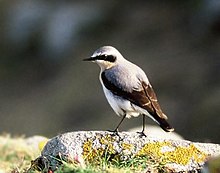Wheatear
Not to be confused with "ear of wheat".
| Wheatears | |
|---|---|

| |
| Northern wheatear (male) | |
| Scientific classification | |
| Kingdom: | |
| Phylum: | |
| Class: | |
| Order: | |
| Family: | |
| Genus: | Oenanthe Vieillot, 1816
|
| Species | |
|
See text. | |
The wheatears /ˈhwiːtɪər/ are passerine birds of the genus Oenanthe. They were formerly considered to be members of the thrush family, Turdidae, but are now more commonly placed in the flycatcher family, Muscicapidae. This is an Old World group, but the northern wheatear has established a foothold in eastern Canada and Greenland and in western Canada and Alaska.
Etymology
The name "wheatear" is not derived from "wheat" or any sense of "ear", but is a 16th-century linguistic corruption of "white" and "arse", referring to the prominent white rump found in most species.[1]
Oenanthe is also the name of a plant genus, the water dropworts, and is derived from the Greek oenos (οίνος) "wine" and anthos (ανθός) "flower". In the case of the plant genus, it refers to the wine-like scent of the flowers.[2] In the case of the wheatear, it refers to the northern wheatear's return to Greece in the spring just as the grapevines blossom.[3]
Description
Most species have characteristic black and white or red and white markings on their rumps or their long tails. Most species are strongly sexually dimorphic; only the male has the striking plumage patterns characteristic of the genus, though the females share the white or red rump patches.
Species list

There are 23 wheatear species:[4]
- Abyssinian wheatear, Oenanthe lugubris
- Arabian wheatear, Oenanthe lugentoides
- Black wheatear, Oenanthe leucura
- Black-eared wheatear, Oenanthe hispanica
- Capped wheatear, Oenanthe pileata
- Cyprus wheatear, Oenanthe cypriaca
- Desert wheatear, Oenanthe deserti
- Finsch's wheatear, Oenanthe finschii
- Heuglin's wheatear, Oenanthe heuglini
- Hooded wheatear, Oenanthe monacha
- Hume's wheatear, Oenanthe alboniger
- Isabelline wheatear, Oenanthe isabellina
- Kurdish wheatear, Oenanthe xanthoprymna
- Mountain wheatear, Oenanthe monticola
- Mourning wheatear, Oenanthe lugens
- Northern wheatear, Oenanthe oenanthe
- Pied wheatear, Oenanthe pleschanka
- Red-breasted wheatear, Oenanthe bottae
- Red-rumped wheatear, Oenanthe moesta
- Red-tailed wheatear, Oenanthe chrysopygia
- Somali wheatear, Oenanthe phillipsi
- Variable wheatear, Oenanthe picata
- White-crowned wheatear, Oenanthe leucopyga
Behaviour
Wheatears are terrestrial insectivorous birds of open, often dry, country. They often nest in rock crevices or disused burrows. Northern species are long-distance migrants, wintering in Africa.
Fossil record
- Oenanthe kormosi (Late Miocenee of Polgardi, Hungary) [5]
- Oenanthe pongraczi (Plioceme of Csarnota, Hungary) [5]
References
- ^ "Wheatear". Merriam Webster Online. Retrieved 13 May 2010.
- ^ "Dropwort, Hemlock Water". A Modern herbal. Botanical.com. Retrieved 2008-02-05.
- ^ "Northern Wheatear". eNature. Retrieved 2008-02-05.
- ^ "ITIS Report: Oenanthe". Integrated Taxonomic Information System. Retrieved 14 May 2010.
- ^ a b Kessler, E. 2013. Neogene songbirds (Aves, Passeriformes) from Hungary. – Hantkeniana, Budapest, 2013, 8: 37-149.
